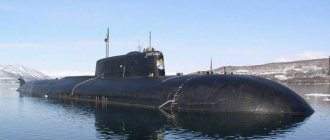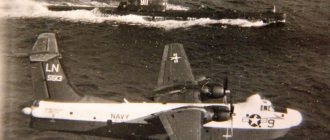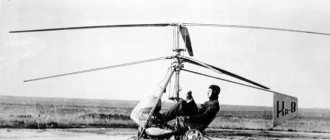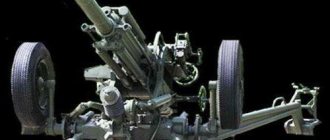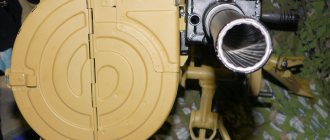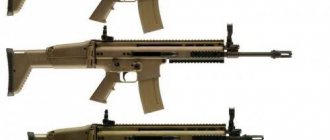The main purpose of the Project 21980 boat is to protect the fleet in ports from sabotage, for which the enemy can use submariners, boats, and small aircraft. The boat carries on board a modern arsenal of means for detecting and destroying various sabotage groups. Combating sabotage in ports does not require a large supply of fuel. Vessels with a displacement of 50-200 tons are optimally suited for this purpose. Small vessels have low operating costs. The rook boat falls into this range. Its displacement is 138 tons. The Project 12980 ship can be used both at sea and on rivers.
The boat solves air defense problems to ensure the protection of small objects, is used to protect the state border, when protecting government officials and during special operations. In mid-2022, about 15 vessels of Project 12980 were built, and their production continues at the shipyards of the Zelenodolsk Shipyard.
Main technical parameters
- Displacement - 138 tons;
- Hull length - 31 m;
- Width - 7.4 m;
- Draft – 1.8 m;
- Maximum speed – 23 knots;
- Cruising range – 200 nautical miles;
- Autonomy – 5 days;
- Crew – 8 people.
The effectiveness of the use of anti-sabotage boats is largely determined by the technical reconnaissance equipment available on board. The basis of reconnaissance assets is the Kalmar hydroacoustic complex. The electronic systems, navigation and communication equipment installed on the boat are all domestically produced. As standard, the full arsenal of reconnaissance technical equipment includes the following components:
- hydroacoustic station Anapa;
- search underwater complex "Squid";
- diving equipment, rubber boats, motors;
- radar station MR-231 “Pal”;
- television complex for surface surveillance MTK-201 M3.
Radar and hydroacoustic stations have computer interfaces. In addition to electronic reconnaissance equipment, there are navigation systems similar to civilian vessels: GLONASS navigation receivers with high positioning accuracy, wayfinding systems, echo sounders, marine VHF radio stations and other equipment standard for sea vessels. The Grachonok boat has an autonomy of up to 5 days, which, with a cruising range of 200 miles, allows it to be used on short-range sea routes. It is also very convenient for use on rivers due to its shallow draft (only 1.8 m).
Location of surveillance and communication equipment on the deckhouse of the boat:
- Television surveillance complex MTK-201 M3 (TV camera, telephoto lens with remote guidance);
- Rotating antenna of the marine radar station MR-231 “Pal”;
- Surface lighting system floodlight;
- High power horn loudspeakers;
- Flagpoles and antennas for local marine VHF radio stations;
- GLONASS antenna under a protective plastic dome.
On the deckhouse of the boat Grachonok there is a universal mast with brackets for attaching any necessary equipment. To operate on rivers, VHF river radio stations are installed. Shortwave (specific long antennas) and satellite communications are also provided.
Characteristics of the Anapa hydroacoustic station:
- detection range of a swimmer wearing fins – up to 300 m (theoretical value);
- detection range of a swimmer using mechanized means of propulsion is more than 400 m;
- simultaneous viewing sector - 360 degrees;
- antenna immersion – up to 40 meters;
- modern station computer interface, target identification system and other features.
Construction and equipment
The Rook boat is a small single-deck vessel with a large superstructure that occupies almost the entire surface of the deck. The first PDRCs - built before 2014 - were equipped with German diesel engines manufactured by MTU.
After the events of 2014, the company refused deliveries, and the remaining “Grachats” received 12-cylinder diesel engines made in China (by the way, also produced under license from the German company Deutz). At the same time, the “analogue” managed to confirm the established opinion about “Chinese quality” - the diesel engines of the P-340 boat failed during testing.
To detect surface objects and navigate, the ship is equipped with an MP-231 radar.
To control the situation in the air, the MTK-201M3 optical-electronic complex is used. In addition to observing the sky, the complex's cameras allow you to view the surface space in the radar dead zones.
The Anapa hydroacoustic complex helps Grachonk solve its main task. A large ship, as a rule, has to look for the noises of submarines, but an anti-sabotage vessel needs to listen to the noises made by its fins. And “Anapa” allows you to detect swimmers at a distance of up to three hundred meters. Detected targets are classified automatically.
Using the Kalmar complex, which includes an echo sounder and sonar, the bottom is monitored. A remotely controlled underwater vehicle allows manipulation of underwater objects. Also on the PDRK, starting with the P-191 “Kadet” (the second “Rook” built), a diving complex equipped with a pressure chamber is installed.
Underwater search complex Kalmar
It includes several sonars of varying resolution: a forward-looking sonar, a multi-beam sonar, a sound speed meter in water (data required to determine the distance to targets), and electronic computing modules. Among the additional equipment, the complex has a navigation system with a GLONASS/GPS receiver. The coordinates of the targets are displayed on the electronic tablet of the complex, and are also transmitted via radio modem to any other necessary equipment. The Kalmar complex was developed by engineers specifically for anti-sabotage boats.
Maritime radar station MR-231 "Pal"
The main purpose of the station is navigation, but it provides solutions to other problems, for example, detection of surface targets. MP-231 is widely used on vessels guarding the state border. The station has low power consumption and relatively low cost compared to other maritime radars of similar power. The target detection range is 10-15 km, and it depends on the height of the antenna. Review period (antenna rotation speed – 20-40 rpm). The locator transmitter operates at a frequency of 9 GHz in pulsed mode with a power of up to 10 kW. The transmitter antenna is a slot antenna on a flat symmetrical panel with rotation. The receiver has access to computers and other equipment in the navigation room. The coordinates are referenced in the GLONASS channel data.
Diving equipment
The Project 21980 boat is used in counter-terrorism, search and rescue operations at sea, which requires good diving equipment. The boat has standard diving kits. Their number and technical characteristics are not specified. It was noted that the boat is equipped with a specialized ship diving complex, developed by Tethys Pro specialists in 2011. The complex includes a pressure chamber that allows maintaining the physiological fitness of divers.
Project 21980 and its application
On February 8, 2008, at the Zelenodolsk Plant named after A. M. Gorky in Tatarstan, the first anti-sabotage boat of Project 21980 “Grachonok” was laid down for the development of “Vympel”. A series of such boats was developed for the Russian Navy with the aim of combating sabotage and terrorist forces and means in the waters of Navy bases, guarded facilities and on the approaches to them, as well as as auxiliary means to assist the Border Service of the Federal Security Service of the Russian Federation (PS FSB of the Russian Federation) when carrying out security and protective measures on the state border of Russia and for the protection of important state facilities from the sea area, which are under the protection of troops of the Russian National Guard.
The boat is capable of performing a wide range of tasks. Its design uses the latest tactical and technical developments. For example, the latest types of weapons, including radio-electronic ones, were installed, and the latest navigation equipment and communications equipment were used.
The Grachonok PRDK turned out to be fast and maneuverable, with high seaworthiness (at a speed of up to 23 knots, it can effectively carry out its tasks in sea conditions of 4 points).
Despite its small size, this boat has quite serious weapons, giving it all the capabilities to perform a number of combat missions that previously had to be performed by ships with large displacement, as well as confidence in the reliable protection of the objects entrusted to it from sabotage and terror.
By order of the Russian Navy, it is planned to build 26 units of the Grachonok PRDK; at present, the order is almost completed, 24 vessels are already in service. Two more are on the way. In addition to its own order, Vympel is also ready for proposals to produce such boats for export. The construction of the boats is underway at three Russian shipyards. Project 21980 boats have already taken root and have proven themselves well in all Russian fleets. The Zelenodolsk Plant named after A. M. Gorky provided them to the Black Sea, Baltic and Caspian fleets. Ships for the Pacific Fleet are being built in Vladivostok. Rybinsk, Yaroslavl region, provides the Grachonok PRDK to the Northern Fleet.
After launching and completion afloat, each boat undergoes factory and then state sea trials. During factory tests, they check the operation of all systems in all operating modes, carry out commissioning work, eliminate defects and prepare for state tests, where they also check the operation of all systems and military equipment, check compliance with the approved design, eliminate identified deficiencies and only then the commission accepts the vessel.
Each ship receives its own side number. The first PRDC "Rook" with tail number P-104 was launched on April 25, 2009 and was assigned to the 105th brigade of ships to guard the Leningrad naval base of the Baltic Fleet in Kronstadt. In 2011, it was exhibited at the International Naval Salon "Lenexpo 2011", where it attracted the attention of many specialists. In 2015, the Project 21980 P-104 PRDK took part in the naval parade dedicated to the 70th anniversary of the Victory, which took place in St. Petersburg, and a year earlier this boat was given the name “Nakhimovets”.
In June 2022, the first of four special-purpose boats PRDK "Grachonok" was launched, according to the contract of the Federal Service of the Russian Guard. Today, all four special-purpose boats serve in a special brigade for the protection of the Crimean Bridge in Kerch.
“PRDK “Rook” is a unique complex that is equipped with ultra-modern equipment that is capable of not only detecting an enemy target on the water, under water, in the air, but also destroying it.
Television surveillance complex
Boats 21980 are equipped with an MTK-201 M3 television surface surveillance system. Data on the technical characteristics of this particular modification have not been specified, but the MTK-201 ME complex is closest to it. Such complexes are installed on the famous Mistral helicopter carriers. They are made on the same design platform and have the following characteristics:
- target detection range: surface 10-20 km (depending on weather), airborne 8-15;
- detection range via thermal imaging channel – 8-16 km;
- laser rangefinder measurement limit – 25 km;
- computer interface, binding to coordinates from a GLONASS/GPS receiver;
- gyroscopic stabilization of all optical devices of the complex.
Armament
- MANPADS-Igla;
- Marine pedestal machine gun mount MTPU for 14.5 mm caliber;
- Anti-sabotage hand grenade launcher DP-64;
- Anti-sabotage multi-barrel grenade launcher DP-65.
MANPADS-Igla
The launch frame contains four 9P39 missiles, which ensure the destruction of air targets at altitudes of up to 5000 m. The course is oncoming and catching up. Aerial targets can be hit in the absence of visibility in the optical range, for example due to weather conditions or night time. The coordinates of air targets are displayed on a portable electronic tablet 1L15-1 from the MANPADS kit; they are received from the boat's onboard radar station, as well as from other sources, for example, from the coastal defense network.
Multi-barrel grenade launcher DP-65
The complex was originally developed as an anti-sabotage system for protection against underwater swimmers, automatic self-propelled devices, as well as some surface targets that can be used to commit sabotage. DP-65 has 10 barrels with a caliber of 55 mm. The firing range is 50-500 m. The weight of the thrown ammunition provides a radius of destruction under water of up to 16 m. The complex is aimed remotely using an electronic control panel. The Project 12980 ship is used for port defense. To completely eliminate errors when firing, the grenade launcher's electronic control panel has restricted zones and sectors, which are entered into the device via various communication channels.
The operation of grenade jet engines is accompanied by the ejection of flame from the back of the barrel. There should be no flammable objects in the 15-meter zone, which is impossible to ensure on small ships, so another solution was applied. The DP-65 grenade launcher is installed on the platform behind the boat's wheelhouse, lined with heat-resistant materials. For reliability, the remote control is made autonomous. Its power source does not depend on the ship's on-board network.
Marine machine gun mount MTPU
It is a 14.5 mm machine gun with a rate of fire of 450 rounds/min. Operated manually by one person without remote control. Cartridges - armor-piercing, incendiary, tracer.
DP-64 hand grenade launcher
A hand-held double-barreled grenade launcher with a caliber of 55 mm was specially designed to protect ships, oil platforms and other important objects from attacks by underwater swimmers. Has advanced capabilities. With two barrels of 55 mm caliber and 600 mm length, it weighs 10 kg. The ship can be in any position when firing. The manual model has no restrictions on firing angles (like a permanently mounted grenade launcher). The power of the reactive charge allows you to throw a depth grenade at 1000 m. The depth of the fuse is set before the shot in advance using a mechanical regulator and is 0-40 m. Also, the DP-64 hand grenade launcher has signal ammunition and others to designate targets.
Combat use
By the time the Shosha machine gun reached the front, the maneuver phase of the war had already ended. And in the conditions of a positional war, he proved himself disgustingly. The weakest point was the shops. In addition to the fact that their characteristic shape made it difficult to carry a sufficient amount, dirt was constantly clogged into the window on the side surface (with the help of which they monitored the consumption of ammunition). The first cartridge, when the magazine was fully filled, tended to turn over, jamming the weapon. We dealt with this by not filling the stores completely.
The large mass of barrel and bolt parts moving inside the body made shooting uncomfortable, and the accuracy of burst fire (even at such a low rate) was insignificant. The light barrel, despite the presence of a radiator, quickly overheated, jamming together with the bolt in the rear position. Due to poor assembly, the screws that connected the weapon parts became loose due to strong vibrations and could simply fall out. Finally, all machine guns assembled had incorrectly aligned sights.
They tried to combat the shortcomings. A cover was put on the magazine to protect it from dirt, but completely enclosed, reinforced magazines entered service with the troops only in 1918. Initially, the Shosha machine gun was created as an individual weapon, but at the front, an assistant was soon assigned to the machine gunner, and by 1917, a crew of four people was attached to the “mobile” weapon.
The American Expeditionary Force, which arrived in France in 1917, did not have automatic weapons, and they had to be purchased “locally,” that is, purchased directly in France. This is how the M1918 modification appeared, using the .30-06 cartridge. The magazine was given a more convenient rectangular shape, but the capacity dropped to 16 rounds.
And more powerful ammunition led to the American machine gun overheating even more readily. Finally, due to errors in the manufacture of the chamber, almost 40 percent of the machine guns were considered unusable. According to the testimony of future General Lemuel Shepherd, if the Americans had received Browning automatic rifles a little earlier, it could have saved many lives.
After the end of the war, they tried to get rid of Shosh machine guns at the first opportunity, selling them to everyone who needed them. So these weapons could subsequently be found in a number of local wars - from the Spanish Civil War to the first Arab-Israeli wars, and a few were seen even in Vietnam. In the 20s, a number were modernized in Belgium - they are considered the most reliable modifications, but they were also withdrawn from service as quickly as possible.
